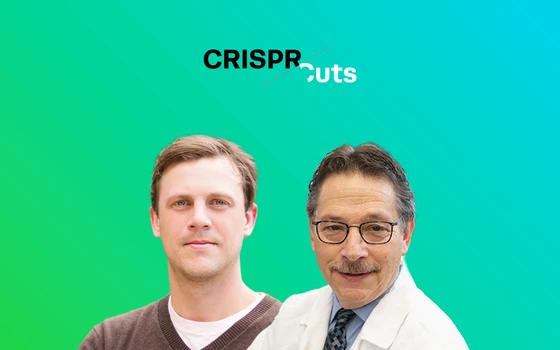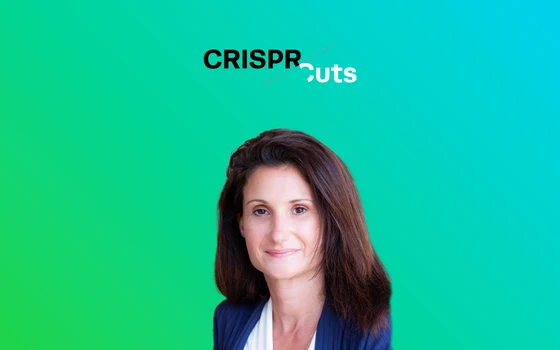Biotech and biopharma companies have made great strides in the world of CRISPR gene editing in 2018, and are paving the way to bring real products to market faster. This hasn’t been the case though, until recent years. There are a number of reasons why biopharma companies have done so well in the past 2 years, and a number of things still holding them back from success in the United States.
In this episode of our CRISPR Cuts podcast, we sat down with Alex Philippidis, a science journalist at Genetic Engineering & Biotechnology News. Tune in to the podcast or read the breakdown of our conversation in the article ahead. The choice is yours!
In this article, he discusses the changing face of the industries of big pharma, biotech, and CRISPR gene editing, as companies raise more money, and the world changes around them. We’ll cover all that, and other relevant topics, including:
- 5 Key Takeaways From This Podcast
- Alex Philippidis’ Background
- Recent Trends in Biotech and Biopharma News
- China vs. the U.S. in the Biopharma Space
- Changes in Biotech & Gene Editing Companies
- The Varying Public Perception of CRISPR
- What Will the Biotech Market Look Like in 2019
- Other Biotech & Gene Editing Podcasts You May Enjoy
Jump down to any topic to learn more, or jump in right here with the main takeaways from our chat with Alex Philippidis.
5 Key Takeaways From This Podcast
In this podcast, we cover the changing world of biotech and biopharma, particularly the trends in the industry in the past two years to predict what’s to come. Here are some of the main points you wouldn’t want to miss:
1. Pharma is becoming more focused and specializedBiopharma companies are trending toward focussing on one area, or a couple of elements within one area, rather than being all over the map with their development, and this is good news for the world of biotech.
Time in podcast: 1:40
Jump down here to learn more
Biopharma companies are trending toward focussing on one area, or a couple of elements within one area, rather than being all over the map with their development, and this is good news for the world of biotech.
Time in podcast: 1:40
Jump down here to learn more
2. China is getting biopharma products faster to the market than the U.S.China’s economic strategies to attract their own domestic talent in the world of biotech, their commitment to education in their country, and their regulations surrounding IPOs allows China to develop better pharma products, and bring them to market quicker than is possible in the U.S.
Time in podcast: 7:35
Jump down here to learn more
China’s economic strategies to attract their own domestic talent in the world of biotech, their commitment to education in their country, and their regulations surrounding IPOs allows China to develop better pharma products, and bring them to market quicker than is possible in the U.S.
Time in podcast: 7:35
Jump down here to learn more
3. Biotech companies are raising more and more moneyAs investors see the opportunity in this industry, they are investing more money in companies, which will lead to more companies developing great products. A competitive space will accelerate products reaching the market.
Time in podcast: 9:45
Jump down here to learn more
As investors see the opportunity in this industry, they are investing more money in companies, which will lead to more companies developing great products. A competitive space will accelerate products reaching the market.
Time in podcast: 9:45
Jump down here to learn more
4. The public perception of CRISPR varies – but in unexpected waysThere are a number of ways that people perceive CRISPR, sometimes regardless of their education or involvement in the world of science. Strides will need to be made to improve public perception, and this falls on the shoulders of biopharma companies.
Time in podcast: 19:45
Jump down here to learn more
There are a number of ways that people perceive CRISPR, sometimes regardless of their education or involvement in the world of science. Strides will need to be made to improve public perception, and this falls on the shoulders of biopharma companies.
Time in podcast: 19:45
Jump down here to learn more
5. 2019 will be a big year for biotechIf 2018 was any indication, there’s a lot coming up in 2019 for biotech and pharmaceutical companies – but there’s also still a lot standing in its way. Whether or not these holdups are resolved early in 2019 will be a good indicator of the future of the industry.
Time in podcast: 24:15
Jump down here to learn more
If 2018 was any indication, there’s a lot coming up in 2019 for biotech and pharmaceutical companies – but there’s also still a lot standing in its way. Whether or not these holdups are resolved early in 2019 will be a good indicator of the future of the industry.
Time in podcast: 24:15
Jump down here to learn more
Alex Philippidis’ Background
Learn more about who Alex Philippidis is, what he’s working on, and how he got into the world of CRISPR.
Brittany Enzmann: Alex, could you please tell us about your background?
Alex Philippidis: I have been a reporter and editor for various news outlets for more than 30 years. Originally, general interest, first weekly, then later daily. I've been covering biotech for more than a decade, including about four years at GenomeWeb, and since 2011 at Genetic Engineering & Biotechnology News with a focus at GEN on biopharma business news and industry issues. My interest was trying to figure out how the world works, and then explain that to others, and that purpose is what drove me into that line of work.
If you would like to get in touch with Alex, you can contact him in the following ways:
Email: [email protected]
Twitter: Alex Philippidis (@AlexWestchester)
Recent Trends in Biotech and Biopharma News
Alex goes into detail about how the changing scope of the economy in recent years has allowed biopharmas to raise more money, leading to further success.
Minu Prabhune: You have a decade of experience writing in biotechnology, so it must have been really interesting to see changing trends over the years. I noticed that you write a lot about pharma and biotech, which is a very interesting field for us in particular because we are a biotech company. Are there any recent trends you’ve noticed?
Alex: The first trend that really struck me in the decade or so of writing in biopharma has been that companies are now more eager to specialize in either one therapeutic area or a cluster of therapeutic areas – say three to five – as opposed to being all over the map.
I think the reason for that is the pressure that comes from investors and managers and others to show results for the money spent. That's one big reason why you see a desire by biopharmas to pursue technology all the way to treatments through external collaborations in partnerships rather than keeping it all in house. The value of the bigger deals now more often crosses that billion-dollar threshold.
For example, every year, GEN compiles a list of the top 10 oncology collaborations. In 2018, we noticed that the total value of the top 10 ranked collaborations was about 34.5 billion dollars, which is up 32% from the 10 deals we ranked in 2017, which added up to about 26 billion dollars. This shows you how much importance the bigger biopharmas that get into these collaborations are placing on cancer immunotherapies.
And if we had to do that list again right now – we will later this year – you can tell there's going to be a new number three because, back in August, we had seen where Genentech had committed up to $5 billion in potential milestone payments and royalties to develop and commercialize novel immunotherapies to treat multiple cancers.
Minu: And would that mean that companies are now becoming even more successful? As you mentioned, these companies are trying to specialize in particular topics, but simply based on their valuation, does that mean biotech is getting more attention now, and are they getting more investment?
Alex: They are getting more investment in the last couple years for two main reasons: the economy improved from the recession of a decade ago, and we've seen more knowledge and interest by investors perceiving potentially big rewards. So, the economy improvement helps, because biotechs have the cutting-edge technologies that the pharma companies want and are willing to spend the money on through milestone and royalty payment tied to sales.
One recent example, just in the past year or two, is that even with the Wall Street slump we saw back in the fall, we saw a lot of IPO activity in 2018. Just this week, GEN came out with the top 10 global biopharma IPOs, and those 10 companies raised a combined nearly $4.3 billion in net proceeds, and that's up about 47% from what was just under three billion, about 2.9 to be more precise, in net proceeds from the 10 companies in the 2017 IPO list.
Another thing that was interesting with the IPOs is that all 10 companies in 2018 raised more than 200 million dollars in net proceeds. We also saw where China-based biopharmas accounted for four of the top five IPOs, which is mainly due to the fact that the authorities in Hong Kong allow for pre-revenue biotechs to begin listing their shares, which resulted in a flurry of IPOs – 17 filed and 6 actually carried out IPOs in 2018.
And I also saw in this country the biggest US IPO with Moderna, an RNA-based drug developer, that raised $604 million on NASDAQ – in December alone. This also demonstrates one of the changes in trends in recent years, which is a tipping point for drugs based on some technologies that have shown success – RNA-based drugs – for example. We saw in August where Alnylam won FDA approval for ONPATTRO, the first of the RNAi-based drugs to win authorization by the agency, though others are expected soon.
China vs. the U.S. in the Biopharma Space
China’s regulatory procedure and their commitment to maintaining domestic talent is helping them get products in biopharma to market faster. Learn more about why this is the case.
Minu: I find it very interesting when you mentioned that a lot of companies from China are on the top biopharmas list, because we've been hearing a lot about China in the biotech space recently. In your experience, do you think that China is growing really fast? And why is it so difficult for the U.S. to keep up with the growing industry in China?
Alex: In China the state has invested a lot in its people, and that investment has gone to education and developing a talent base. For a long time, the thought was that China was a good place to manufacture perhaps and to do so cheaply compared to the West. But until recent years, there was not as much emphasis on how they are developing innovative drugs and bringing them to market.
You've seen where there's been anecdotal increases in patent filings in China compared to the U.S. You've also seen companies – homegrown companies – that have not only been able to make use of domestic workforces, but to re-attract professionals who had received their educations in the United States or the West to come back to China. And this is something the state has encouraged in recent years as a way of growing a domestic biotech industry. The Thirteenth Five-Year Plan of a couple years back had pinpointed biotech as one of a half dozen technology-based industries that the state wants to see expand.
This emphasis on maintaining talent has helped with China’s development in the world of biotech. You see the results on the Hong Kong and Shanghai and Shenzhen exchanges with new companies listing. I think that Hong Kong has gotten the most attention in the U.S. because the values that companies raised by going public there has been rather high.
Changes in Biotech & Gene Editing Companies
The economy has changed the way gene editing technology is turning into real products for consumers, which changes investors’ interest in it.
Brittany: One of the things you have found is that more and more companies are becoming interested in gene editing. Could you elaborate on why that might be?
Alex: In that aspect, we've seen two main developments that interest me.
1. The slow but sure rise of gene editing speciality companies showing early promiseAlex: There are many companies that are perfect examples of this concept. You have CRISPR Therapeutics which began phase 1/2 trials for a therapy that it's co-developing with Vertex. And it's CTX001 in Beta thalassemia and sickle cell disease in January just earlier this month that got fast-tracked from the FDA in sickle cell disease. That means that there's more agency interaction, at least as long the shutdown of the government doesn't affect it too much, and the possibility of a quicker approval.
That is an ex vivo CRISPR gene-edited therapy. It's for patients who suffer from Beta thalassemia or sickle cell disease. A patient's hematopoietic stem cells are engineered to produce high levels of fetal hemoglobin in red blood cells. And it is thought that by elevating HbF through CTX001, that has potential to ease up on the transfusion requirements for beta-thalassemia patients as well as the sickle crises that sickle cell patients endure.
Another interesting company is Editas Medicine. And at the recent J.P. Morgan conference earlier this month, they said they plan to initiate patient screening and patient dosing later this year for their first to the clinic treatment, EDIT-101. They're calling it the first in vivo CRISPR clinical trial in history. And that's a genome editing treatment candidate for Leber Congenital Amaurosis type 10, or LCA10.
Now, Editas has partnered on the development of this with Allergan in a deal that could generate up to $40 million for Editas. And that's one of several reflections of how some bigger biopharmas are starting to get interested in these technologies. A better example of big partners and big-name collaborations is with Intellia Therapeutics. They've got two late-stage preclinical programs. But they're still got some big names interested.
One is for ATTR, or transthyretin amyloidosis, and Intellia is partnered with Regeneron on that. Now they're conducting preclinical studies, and if that testing goes well, the thought is that they might be able to begin clinical testing in humans in the year 2020. Also, Intellia has a candidate in sickle cell disease with which it's partnered with Novartis, and that partnership goes back a couple years, was expanded just last month in December to include ex vivo development of cell therapies using ocular stem cells.
Novartis would get the right to develop CRISPR-Cas9-based products for one or more targets using these cells, and in return, Novartis agreed to pay Intellia $10 million one time, and Intellia could also get milestone and royalty payments if the collaboration succeeds. Now those three companies, CRISPR Therapeutics, Editas, and Intellia, are basing their gene editing therapeutics on CRISPR-Cas9. A whole different technology is employed by an actually older company in the field, Sangamo, and they're constructing zinc finger nucleases.
Those are based on human proteins that are designed to recognize specific DNA sequences, and Sangamo says these offer high efficiency and extreme specificity. At J.P. Morgan, they presented data on a study of one drug candidate based on zinc finger nuclease technology designed to modify liver cells, which are deficient in Hunter syndrome, or MPS II. When Sangamo presented data on SB-913, they emphasized the significant reduction in glycosaminoglycans, or GAGs, that accumulate in MPS II.
However, there was concern, at least based on reports by analysts and others who commented on the presentation afterward, that they had a hope that Sangamo would have been able to show that its therapy was actually increasing IDS levels. That may emerge later this year, though, because they've got additional data coming soon, so for now, it remains to be seen whether Sangamo's been emphasizing a 51% total reduction in GAGs with two GAGs that they've identified in specific that have shown significant decreases, dermatan sulfate and heparan sulfate.
Alex: There are many companies that are perfect examples of this concept. You have CRISPR Therapeutics which began phase 1/2 trials for a therapy that it's co-developing with Vertex. And it's CTX001 in Beta thalassemia and sickle cell disease in January just earlier this month that got fast-tracked from the FDA in sickle cell disease. That means that there's more agency interaction, at least as long the shutdown of the government doesn't affect it too much, and the possibility of a quicker approval.
That is an ex vivo CRISPR gene-edited therapy. It's for patients who suffer from Beta thalassemia or sickle cell disease. A patient's hematopoietic stem cells are engineered to produce high levels of fetal hemoglobin in red blood cells. And it is thought that by elevating HbF through CTX001, that has potential to ease up on the transfusion requirements for beta-thalassemia patients as well as the sickle crises that sickle cell patients endure.
Another interesting company is Editas Medicine. And at the recent J.P. Morgan conference earlier this month, they said they plan to initiate patient screening and patient dosing later this year for their first to the clinic treatment, EDIT-101. They're calling it the first in vivo CRISPR clinical trial in history. And that's a genome editing treatment candidate for Leber Congenital Amaurosis type 10, or LCA10.
Now, Editas has partnered on the development of this with Allergan in a deal that could generate up to $40 million for Editas. And that's one of several reflections of how some bigger biopharmas are starting to get interested in these technologies. A better example of big partners and big-name collaborations is with Intellia Therapeutics. They've got two late-stage preclinical programs. But they're still got some big names interested.
One is for ATTR, or transthyretin amyloidosis, and Intellia is partnered with Regeneron on that. Now they're conducting preclinical studies, and if that testing goes well, the thought is that they might be able to begin clinical testing in humans in the year 2020. Also, Intellia has a candidate in sickle cell disease with which it's partnered with Novartis, and that partnership goes back a couple years, was expanded just last month in December to include ex vivo development of cell therapies using ocular stem cells.
Novartis would get the right to develop CRISPR-Cas9-based products for one or more targets using these cells, and in return, Novartis agreed to pay Intellia $10 million one time, and Intellia could also get milestone and royalty payments if the collaboration succeeds. Now those three companies, CRISPR Therapeutics, Editas, and Intellia, are basing their gene editing therapeutics on CRISPR-Cas9. A whole different technology is employed by an actually older company in the field, Sangamo, and they're constructing zinc finger nucleases.
Those are based on human proteins that are designed to recognize specific DNA sequences, and Sangamo says these offer high efficiency and extreme specificity. At J.P. Morgan, they presented data on a study of one drug candidate based on zinc finger nuclease technology designed to modify liver cells, which are deficient in Hunter syndrome, or MPS II. When Sangamo presented data on SB-913, they emphasized the significant reduction in glycosaminoglycans, or GAGs, that accumulate in MPS II.
However, there was concern, at least based on reports by analysts and others who commented on the presentation afterward, that they had a hope that Sangamo would have been able to show that its therapy was actually increasing IDS levels. That may emerge later this year, though, because they've got additional data coming soon, so for now, it remains to be seen whether Sangamo's been emphasizing a 51% total reduction in GAGs with two GAGs that they've identified in specific that have shown significant decreases, dermatan sulfate and heparan sulfate.
2. The rise of companies in the gene editing space and the amounts they can raise
Alex: The other main subject of interest in the gene editing space is the difference in the top gene editing companies from recent years. In November 2018 at GEN, we ranked the top companies in gene editing-based technology, both public and private; we ranked the public companies by revenue, and the private companies by total capital raised. We found there has been big financing for these companies, and one very recent example from October 2018 is Synthego, a genome engineering platform developer, who received $110 million in Series C financing.
Earlier in 2018, we see Beam Therapeutics, who launched in May, and got $87 million in Series A financing. The co-founders of Beam include Feng Zhang, a pioneer of CRISPR-Cas9. Beam says they're looking to pursue new therapies using CRISPR technology, although I think more of the headlines were focused on Feng Zhang joining in as a co-founder.
But there have been some even bigger financings, one in the agricultural genome editing space was Pairwise who raised $125 million, although that included $100 million from Monsanto before the completion of the Bayer acquisition. They also got some Series A financing, $110 million in Series B money by a company called Precision BioSciences, a single financing, and they're looking to further product development based on their own ARCUS gene editing platform. It's derived from a natural genome editing enzyme called a homing endonuclease.
With those and additional companies raising big sums, you're going to see a lot more players over time. And then, it will be up to them to use the money to actually succeed – and maybe some will get acquired in due time – but the field is definitely going to look beyond just the CRISPR-Cas9 players that have been getting a lot of the attention at the moment.
Minu: I think that it's very interesting to know that pharma companies and biotech companies are more frequently collaborating rather than competing for the same methods, because that is definitely what we need for more clinical trials in the future.
The Varying Public Perception of CRISPR
Alex believes there are groups within groups when it comes to the understanding of CRISPR and what it’s impact will be. Learn more about his impression of the various opinions on the subject.
Minu: As a journalist, I'm curious to know whether people are as excited about these companies and their corresponding gene editing technologies as people in the biotech space are. What do you think the public perception right now is about CRISPR?
Alex: I think there are a couple of publics. I sense a lot of excitement in the public that is within biopharma and within broader science, but there’s caution there as well because many of the technologies have yet to thoroughly play out – let alone succeed.
I think there's more cautious optimism there as well, especially in instances like what we saw with He Jiankui and the controversial genome editing study that resulted in the birth of twins. That led to criticism within the science community about whether his attempt to edit the CCR5 gene qualified as an unmet medical need, what the informed consent approval processes was, and the way he timed and released the news of the study.
But outside of this community, there's another public, and it's a broader public that has, frankly, less involvement in the science world. And if my Facebook feed is any indication, I see trouble. And that trouble is coming not just from people without science education, but from people who are well-educated in business or the arts or many other professions I know who don’t have a lot of knowledge about gene editing or science in general. They might go by headlines in general interest news, or worse, chat with their friends who are also not too technically knowledgeable.
And so, more often than I'd like, I hear fears expressed about playing god or creating a master race expressed very casually. Now I think it arises from a legitimate concern that the tools of gene editing may be abused by some for financial or personal power or other purposes. I think it's important to remember that CRISPR gene editing is a tool. It can be used for good, such as to treat disease, or it can be used for vanity purposes. I think the challenge here is for responsible professionals and organizations, especially those in the biopharma and gene editing communities, dare I say, "the ecosystem."
They need to address the issue by developing guidelines for responsible use of the technologies that are a consensus that most can go along with. And I understand that some researchers may not fall into line with these standards, but it's not a reason not to address this. I think a responsible framework could go a long way toward addressing the public in political concerns that arise.
I also believe that one of the reasons why there's worry is the unease over how society pays for treatments. On the one hand, it's dazzling to see some of the new technologies and treatments being developed, and at the same time, there's still such a challenge about how to get these new treatments priced so that the industry feels it's getting back something for its investment. Yet, governments and payers feel they're paying a fair price, and people who need the drugs, the patients, don't feel they should have to visit the poorhouse just to stay well.
That's a broader issue that winds up eroding support for new treatments that do work. That's a continuing challenge, I think, for biopharma, and the gene editing community. And they can help by showing what a responsible approach to addressing new technologies should be.
What Will the Biotech Market Look Like in 2019?
2018 was a big year for biotech and biopharma companies, and there’s more to come. Learn about what’s exciting, and what’s still holding the industry back.
Brittany: 2018 has really been a great year for biopharma as you have described. What does 2019 look like?
Alex: It could be good, but we don't know, or at least I don't know, because I see a couple of uncertainties that I'm waiting to clear up – at least I'm hoping they'll clear up earlier in this year rather than later. I think the one major uncertainty is the state of the financial markets because they've yo-yo'd just in recent months, let alone years. We've seen if you go back even three or four years, we saw, at least in the states, a slump because there was uncertainty over whether drug prices would be curbed.
Then market rallied when it became evident that there would not be any price curbs and that a larger company could enjoy the tax cut that was enacted at the end of 2017. However, in this past year, we've seen where biopharma stocks have been caught up in the overall market slump where stock prices have fallen. And yet, if you look back since later December, since around Christmas time, you're seeing an uptick again in biopharmas.
A good place to see that yo-yo is the ETFs, or, electronic transfer funds. These are the groups of biotech or pharma stocks that investors who maybe aren't as knowledgeable, instead of investing in an individual stock, they may invest in a group of stocks. And we've seen some of those prices bounce back.
One example is the iShares NASDAQ Biotechnology ETF. Since 24 December 2018, the price of the combined stock had gone up 20 dollars per share from $89.61 to $108.56. You've seen some similar bounce backs with some of the other ETFs, and that’s great for now, but is that going to continue, or yo-yo back down? Nobody really knows, and it remains to be seen.
Whether investors are willing to continue showering these biopharmas with tens or hundreds of millions of dollars in private capital is also still up in the air. We've definitely seen that in the last year and a half, but over time, investors are going to want to see results either individually or if the overall financial markets fall, and that gives investors a reason to dial it back.
Another thing you wouldn't think would be an uncertainty but currently is, is the state of the science itself. With a lot of companies expected to issue data or pursue their own clinical trials, investors and others will be watching and waiting to look for the successes. They hope to spot them early, and then follow along and direct investments in, say, continued progress in cancer immunotherapy if that happens as we've seen in past years.
I think it could be a good year, but there are still a couple of clouds in the sky to sort through.
Minu: I loved your synopsis of the stock market because here in Silicon Valley, I have a lot of friends in tech who keep track of the stock market., and they would always be talking about all the tech companies, and how it's great to see that biotech is entering those conversations and even who's not in the field is also becoming more aware of these growing companies and these growing trends. So that's really great to see.
As a journalist, my final question for you would be, have you had any celebrity moments? Because I'm sure you always interview amazing people, and I recently had one when I interviewed Carl Zimmer. I’m curious to see if you've had such a moment too.
Alex: Yes. I've interviewed people across the board, but the first person I think of – and you wouldn't think of this as an obvious answer because he's not really in the science world so much – was a truck driver I interviewed many years ago when I was just starting out as a reporter. What struck me was that he offered some timeless advice.
He had run after a mugger who snatched a woman's chain, and he was able to catch the assailant and bring him to the police. And the one thing that struck me was he said, "Treat others the way you want to be treated." And I think, though that may sound ‘Sunday school’ to some, I think it's a very sound approach whether you're driving a truck, or you’re in the lab. It always struck me that in order to succeed in the news or in any business, you first have to master being a human being.
Other Biotech & Gene Editing Podcasts You May Enjoy
If you enjoyed this talk, you may enjoy some of these other podcasts about biotech, gene editing, and CRISPR. If you’re looking for more, check out the list of the top CRISPR podcasts.
Alison Van Eenennaam Edits Cattle Using CRISPR
If you’re interested in biotech, check out this real-life application of how gene editing could change the cattle industry with CRISPR cows.
Learn how average moms have been navigating the world of biotech GMO foods, and how their perceptions are helping to shape the perception of biotech in the real world.
Andrew Porterfield Discusses CRISPR in the Grocery Store
Learn more about how CRISPR has entered the world of food, and exactly when you’ll be seeing CRISPR foods in your local grocery store.
No singular episode to share here, as this podcast goes in-depth with biotech every week! Learn about all things newsworthy in biotech, and about the new applications of CRISPR editing in the industry.
If you need more CRISPR, take a look at our massive list of the best CRISPR news sources to get your fill of biotech news.







